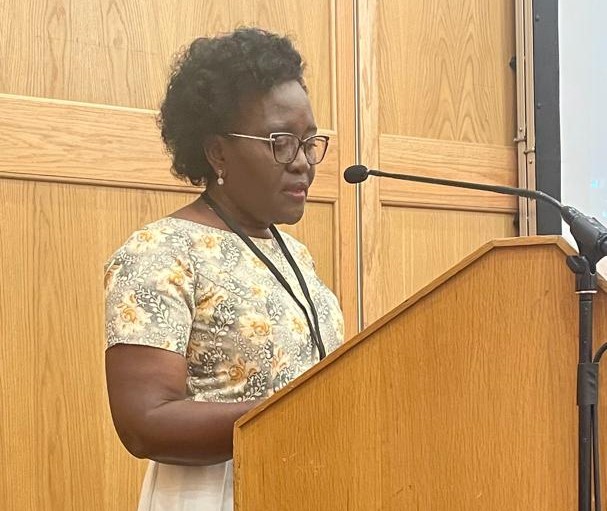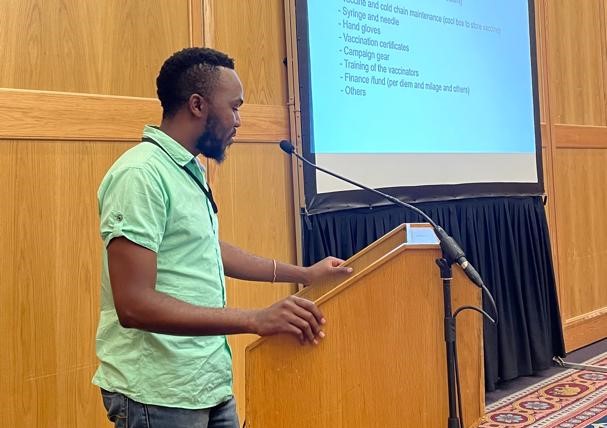In 2022, the Federal Ministry for Economic Cooperation and Development (BMZ) of Germany funded a project in Namibia to support the Directorate of Veterinary Services (DVS) of the Ministry of Agriculture, Water and Land Reform in implementing rabies and transboundary animal disease control. The project, named “One Health approach towards control of rabies and transboundary animal diseases” (OHRT) aims to strengthen animal health systems in the Northern Communal Areas (NCA) of Namibia, focusing on supporting dog-mediated human rabies deaths’ elimination as well as foot and mouth disease (FMD) and peste des petits ruminants (PPR) surveillance and movement control. The project is administered by WOAH.
A consultative stakeholder meeting/workshop was held from 7 to 8 March 2024 in Windhoek, Namibia to review 2023’s activities and prepare the action plan for 2024. The meeting was attended by 60 stakeholders, including officials from the Directorate of Veterinary Services (DVS), the Ministry of Health and Social Services, University of Namibia (UNAM), the Veterinary Association of Namibia (VAN), the Cheetah Conservation Program (CCP), WOAH, the Friedrich Loeffler Institute (FLI), the Global Alliance for Rabies Control (GARC), and the Institute of Veterinary Services of Angola.
Opening session of the meeting/workshop, CVO of Namibia delivering welcome remarks. Picture © T. Tenzin (woah) 2024
The meeting began with remarks from Namibia’s Chief Veterinary Officer, Dr. Albertina Shilongo, who acknowledged the reduction in human rabies cases since the project started in the NCA in 2016. She thanked the German government and WOAH for financial and technical support and other stakeholders for the continued collaboration to achieve the goal of zero human deaths due to dog-mediated rabies by 2030.
Other speakers at the workshop, such as Ms. Philomena Ochurus from the Ministry of Health and Social Services, emphasised the importance of surveillance, data collection, and information sharing.
Dr. Samo Daniel from the Institute of Veterinary Services (Instituto dos Servicos Veterinarios, ISV) of Angola highlighted Angola’s efforts in rabies control in Angola and along the border between Namibia and South Angola.
Presentation of rabies activities during 2023 in Namibia by national rabies coordinator. Picture © Tenzin Tenzin (woah) 2024
Dr Thomas Muller from the Friedrich Loeffler Institute (FLI) in Germany, a WOAH Reference Laboratory, acknowledged Namibia’s achievements and commitment to provide continuous technical support to realise the goal of Namibia’s rabies elimination programme. Mr. Thomas Feidiker from the German Embassy praised the successes of the German-funded phases of the project in Namibia, noting the importance of rabies and transboundary animal diseases control for the region’s economic prosperity.
Dr. Moetapele Letshwenyo, WOAH Representative for Southern Africa stated that the Namibia Rabies Project has reached a milestone by achieving a reduction in rabies cases both in animals and in humans through improved collaboration between animal and public health sectors using the One Health approach, as well as through technical support from other partners such as WOAH, FLI, and GARC. He also emphasised the documentation of project activities and the lesson learned to be shared with wider communities through scientific publications.
Presentations and discussions on rabies focused on the review of progress made in 2023. In 2023, the Namibia Rabies Control Programme made significant progress in its efforts to control dog-mediated rabies in the Northern Communal Areas (NCA). A key achievement was the vaccination of approximately 113,032 dogs, a 49.95% increase from the previous year, although coverage varied across different regions. Educational initiatives reached around 26,000 students, raising awareness about rabies. Rabies surveillance efforts investigated several suspected cases, yielding a 43.9% positivity rate across different animal species, though significant reductions in animal rabies cases were not observed. Challenges included inconsistent vaccination campaign durations and budgetary and transport constraints.
The MOHSS reported five human rabies deaths in 2023, a reduction from seven in 2022. MOHSS is also developing strategies to support One Health approaches and rabies case investigations. Updates from various organisations, including the Friedrich Loeffler Institute (FLI) and the Central Veterinary Laboratory (CVL) in Windhoek, showcased initiatives to improve diagnostic capacities and enhance the understanding of rabies epidemiology in the region.
Non-governmental organisations (NGOs) such as Have a Heart Namibia, the University of Namibia (UNAM), and the Cheetah Conservation Fund (CCF) played a pivotal role in dog population management, rabies control, and awareness education in Namibia. Dr. Andre Coetzer from GARC emphasised the crucial role of NGOs in rabies prevention and control within rabies-endemic regions worldwide. He highlighted that NGOs complement government efforts by reaching areas where government efforts may fall short and providing additional services such as dog population management and running vaccination campaigns on behalf of the government. This collaboration between NGOs and national governments enhances rabies elimination efforts and improves animal welfare.
The benefits of using mobile technology to track dog rabies vaccination and rabies surveillance in Namibia was also discussed. The Directorate of Veterinary Services (DVS) employ a mobile app to track dog vaccination and the meeting recommended to adopt a mobile app for dog vaccination data management to facilitate data-driven decisions in planning mass dog vaccination (MDV) campaigns.
Dr. Samo Daniel provided an update on the rabies situation in Angola and plan of action for their mass dog vaccination campaign.
The meeting/workshop provided an opportunity for active discussions on rabies and emphasised the need for improved collaboration between the human and animal health sectors to improve dog vaccination coverage. Training sessions for medical professionals and the participation of NGOs in rabies control efforts were also acknowledged as key aspects of the programme’s progress. However, gaps in data sharing between NGOs and the Directorate of Veterinary Services were identified, with recommendations made to improve coordination and reporting.
The meeting endorsed the work plan for 2024, which prioritises mass dog vaccination campaigns, rabies surveillance, education, and capacity building, aiming for continued progress toward eliminating dog-mediated human rabies in Namibia.
During the second half of the meeting, the Transboundary Animal Diseases (TADs) control programmes, particularly against foot-and-mouth disease (FMD) and peste des petits ruminants (PPR) were discussed. The review highlighted key activities funded under the BMZ OHRT project, including the procurement of test kits and sampling materials for FMD and PPR surveillance efforts in the Northern Communal Areas (NCA), which found no evidence of PPR, nor FMD circulation. Additionally, the construction of 15 crushpens across four regions is ongoing, in order to enhance disease surveillance. Various capacity building initiatives for paravets and vets including disease outbreak investigation and response, risk analysis, geographic information system and disease mapping and awareness training for around 2,000 livestock farmers have been implemented. A cross-border meeting on TADs and rabies was held in Namibia and was attended by officials from Angola, Botswana, Namibia, Zambia, and Zimbabwe. Angola also provided an update on the FMD and PPR situation, noting sporadic FMD outbreaks in southern Angola bordering Namibia, but no reported PPR cases since 2013.
The meeting prepared an action plan for 2024, which includes conducting FMD and PPR surveillance and surveys, post-vaccination sero-monitoring against FMD, and studying cattle and small stock movements to inform disease prevention and control efforts and capacity building on disease prevention and control.



